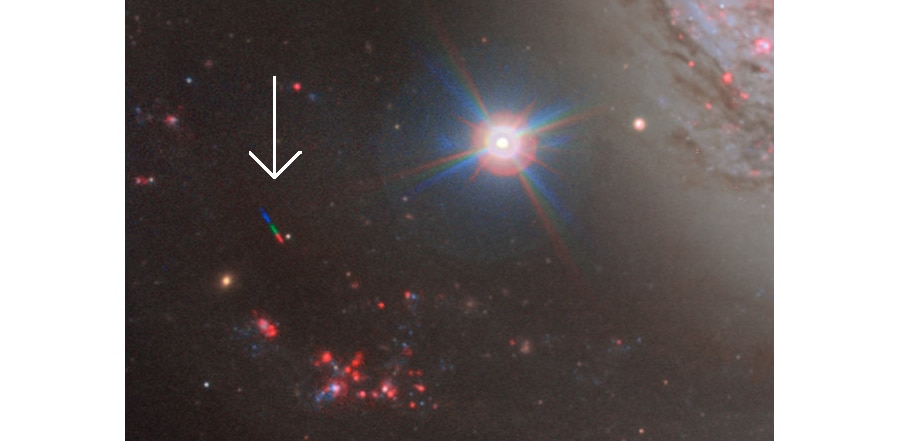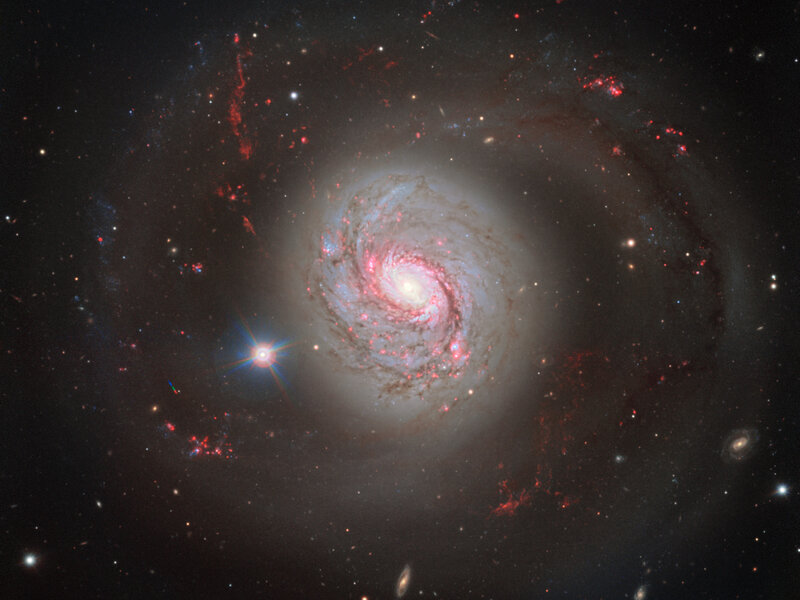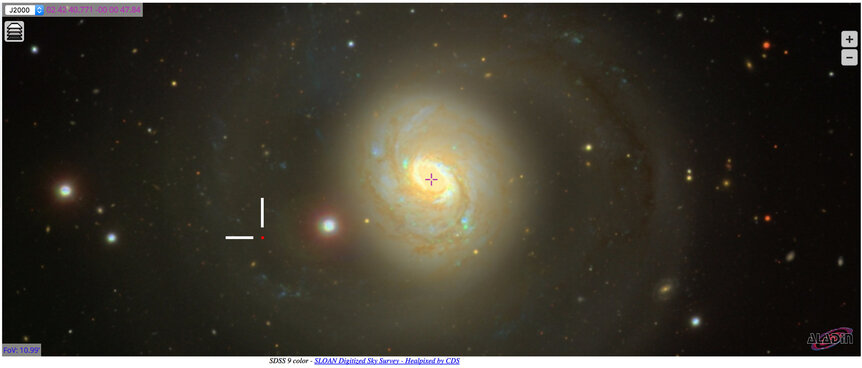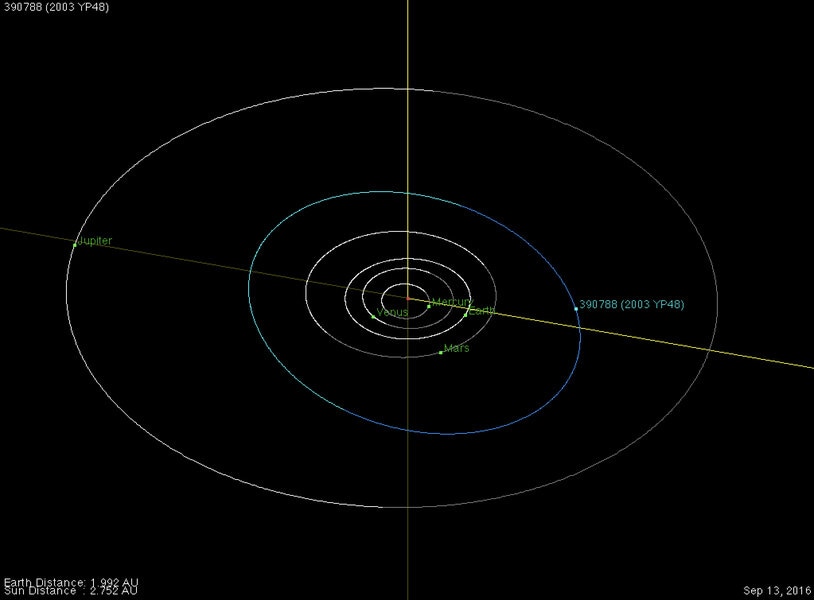Create a free profile to get unlimited access to exclusive videos, sweepstakes, and more!
Mea Culpa: Asteroid vs. Satellite

I made a mistake in a recent post. That happens sometimes, and usually it just means a quick correction and update to clear it up. But in this case I need to explain it a bit more because what unfolded after is pretty cool, and is a wonderful example of how science works.
On July 7, 2017, I posted a gorgeous picture of a galaxy taken by the Very Large Telescope (or VLT). Called M77, it's a nearby very nearly face-on spiral with lots of interesting stuff going on with it.
In that article, though, I decided to focus on something odd in the image itself. To the lower left of the galaxy center is a multi-colored streak. That is clearly something that moved in the sky between and during exposures —the final image is a composite of several images taken through different filters, layered together to approximate a natural color image. If something moves, then it appears as a streak in each exposure, and the process of adding them together produces the polychromatic nature of the final streak.
My first thought was that it was either an asteroid in the solar system or an artificial satellite orbiting the Earth. I've seen asteroids in images before, and they tend to leave long streaks, so I dismissed that. Then I sleuthed around, finding evidence that it was a satellite, specifically a geosynchronous sat that orbits over Earth's equator, so that's the conclusion I landed on.
After I posted it, though, people started commenting (see the updates at the bottom of the article). One person noted the streaks were too short to be a satellite because the VLT would have tracked on the galaxy, so in even a few seconds the sat streak would've been quite long. Someone else pointed out that from the Southern Hemisphere (the VLT is in Chile) geosynch sats would look to be farther north due to the viewing angle.
Then my friend and astronomer Adam Block sent me a note. He did the math and found that a geosynch sat would move a long way in an image like this even if the exposure times were short. At that point I knew it wasn't a satellite anymore, and that it must be an asteroid. I updated the post, lamenting that without the exact time and date the images were taken, we'd never know what asteroid it was. So I figured that was it.
But it's not over! Master astrophotographer André van der Hoeven then sent me a note. He told me that the observation data using the VLT is in fact in an online database that can be queried. I didn't know that! I wish I had, because I would've known what to do next. Happily, André did it for me, and I followed his steps, reproducing his results.
He searched the database for observations of M77 by the VLT (noting that the instrument used was FORS2 for imaging, and using a search region of 15 arcminutes, sufficient to look around the galaxy near where the streak is located in the image) and found the right ones: They were taken on Sept. 13, 2016. He then went to the Minor Planets Center website, where astronomers keep track of the known asteroids and other small bodies in the solar system. There is software there that allows you to enter the date and time of your observations and what part of the sky you're interested in. It returns a list of asteroids in that area at that time! Amazing.
Putting in the date/time of the observations and the location of M77, three asteroids are returned: 2003 YP48, 209 JH8, and 2008 EA53, plus their locations at the time the observations were taken.
Next step: Fire up Aladin Lite, a browser-based sky viewing map where you can enter the name or coordinates of an object and it will put up an interactive display of it. You can choose what sky catalog to use — the Sloan Digital Sky Survey gave me the best image of M77. The next step is to simply move the cursor near the position of the streak in the VLT image and see if any of the asteroids' positions match …
BOOM! The coordinates of 2003 YP48 are a near exact match. We have a winner! Not only that, but André checked, and the colors of the streaks match the order the images were taken (blue, green, then red). As I noted in the original post, the final image of the galaxy uses four filters; the fourth was an H-alpha filter, which highlights star-forming regions. However, there is no fourth streak from the asteroid. Why not? Looking at the database, I see many H-alpha observations, but none on that night. The people who created the image obviously used an H-alpha observation taken at a different time, as I had surmised in my original article. That's why we don't see the asteroid in that filter. It was in a different part of the sky at that time.
André then took one more step: Using the exposure time, he figured out how far the asteroid would have moved in a single observation … and found the streaks again lined up nicely. This is clearly YP48.
Going one more step I looked up the orbit of the asteroid on the JPL Small Body Database browser. 2003 YP48 is a main belt asteroid, and at the time of the observations was 412 million kilometers from the Sun and 300 million kilometers from Earth. It has a mildly elliptical orbit that keeps it between Mars and Jupiter, taking 4.5 years to make a complete orbit around the Sun. I see it has an absolute magnitude of 16.4 — that’s a standardized way of calibrating asteroid brightnesses. That means it’s probably 1.5 – 4 kilometers wide.
So how about that? An incorrect speculation on my part fed the curiosity of a few folks, and then led to an interplanetary detective case. Evidence was collected, forensics was applied, and a culprit was established beyond a shadow of a doubt.
And that, my friends, is science! You make an observation, come up with ideas to explain it, then publish. Others come in to critique it. Sometimes mistakes are made, but when they are the scientist has to own up to them. That allows the gate to open to better understanding, and sometimes even a firm conclusion. And this time it did exactly that.
And then I get to say, with the help of my colleagues, something you rarely ever get to in science: Case closed!































